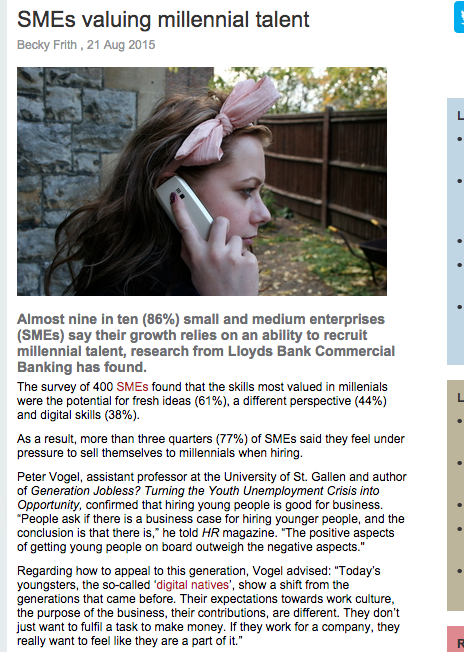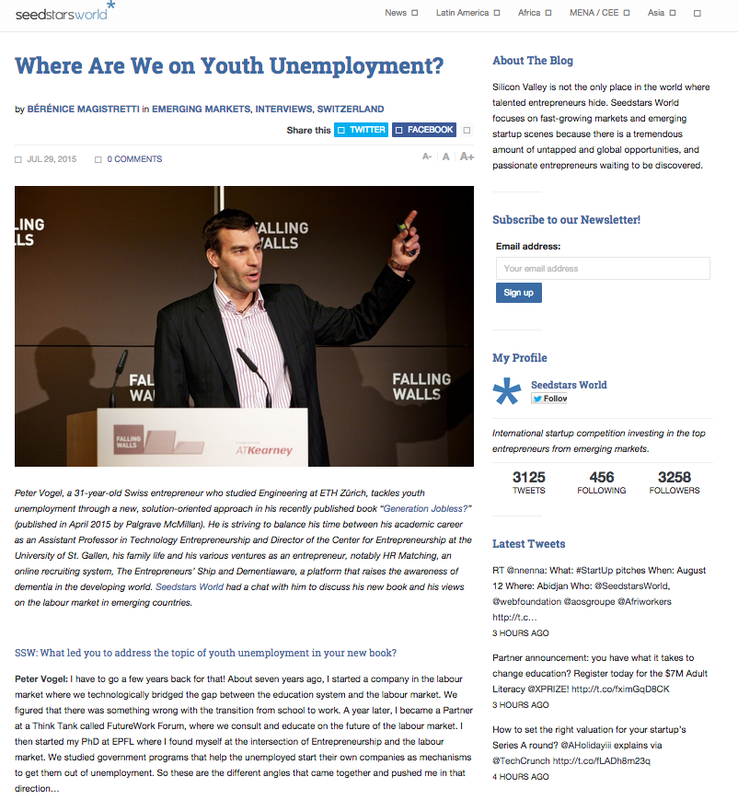|
Link to article here.
0 Comments
.Read my latest contribution on entrepreneurship as a solution to the youth unemployment crisis to the magazine Business Insider of the American-Hellenic Chamber of Commerce. Full article here. "Generation Jobless?" was again featured in CNN Expansion. Read the full article here: http://www.cnnexpansion.com/especiales/2015/11/30/muy-millennials-pero-muy-ninis
New series of articles in 'Business Partners' by the American-Hellenic Chamber of Commerce9/29/2015 The first of several articles on youth unemployment have been published as part of the magazine "Business Partners" by the American-Hellenic Chamber of Commerce. We will now release related articles over the course of the next year. Read the full article here.
Future of work: Skills and job requirements in the 21st century: Article on realbusiness.co.uk9/24/2015 Keep reading here...
Last week, we hosted a webinar on the topic of "From Education to Employment: Bridging the Job Market Gap" with Making Cents International.
After a short keynote from my side, Michelle Blanchet (The Educator's Lab) and Carsten Sudhoff (Circular Society) joined in and we had a great panel discussion. There were roughly 300 participants from all around the world and it led to a great discussion (which continues in this Google Group). You can watch the webinar here:
You can find my slides also here:
A new interview on Smart Remote Work about "Generation Jobless?" and how the concept of remote work might help tackle youth unemployment. Read the full interview here.
I was interviewed by Nathaniel Lathrop from Ground Truth about Generation Jobless.
"In the midst of continuing globalization and the lingering aftermath of the 2008 financial crisis, youth unemployment has emerged as a dire and worsening problem that spans continents." Continue reading here... http://www.globalpost.com/article/6601124/2015/07/01/too-few-jobs-young-workers-global-hunt-solutions Last week I was interviewed by Wade Danielson from The Entrepreneurs Library on 'Generation Jobless?'. Introduction (0:39) My name is Peter Vogel and I’m an entrepreneur myself. I started a company related to the labor market 8 years ago, where we technically bridge the gap between the education system and the labor market. Having done a PhD studying active labor market policies that help unemployed individuals transfer to self employment combined with my company gave me some insights into the youth labor market crisis that occurred over the past few years. I’ve started several companies over the years and have supported entrepreneurs starting up companies, I’ve invested in a few startups, and I teach and run the center for entrepreneurship at a university in Switzerland. The Book’s Unique Quality (06:23) Surprisingly there are very few books on the youth unemployment crisis and the vast majority of material that is being published on it is just governmental reports and policy reports. Media outlets all over the world cover the topic but just statistically, it hardly ever goes on the dramatic perspective on the crisis. That in itself, this case driven approach, this solution driven approach is what sets the book apart. The Best Way To Engage (09:13) It’s separated into two parts. The first part is more of a conceptual and theoretical part in order to give people insight so they get a clear understanding of the crisis. The second part is basically jumping from stakeholder to stakeholder: policies, educators, employers, entrepreneurs, parents, organizations, etc. and picks up very specific hands on solutions. So you can read the book from page 1 to the end or you can read it as part one and part two. The Reader’s Takeaway (24:47) It really depends on which angle the reader is taking. If we are talking about a business leader/entrepreneur then I think it’s really this idea of this business case for hiring young people as opposed to hiring senior individuals. It clearly spells out the advantages and disadvantages of hiring young people and what employers need to do to hire the right talent. A Deep Dive Into The Book (12:32) As I touched upon, it’s broadly sectioned into two parts with part one being structured in three core chapters. The first chapter is probably the most theoretical of all in the book, where it’s really about understanding why we are in this situation. Where did this whole crisis come from? What are the drivers? What are the causes? Which are broadly categorized in demand side factors and supply side factors and then mis-match factors between the two. Chapter two is easier to digest and less theoretical. It basically gives some insight into who are today’s young people, the millennials, the digital natives, what characterizes them, and what is the contribution of this generational change and technological revolution that has taken place. It also dives into how this generation is handling the crisis and how employers need to be ready to employ them with incentives that match the desires of today’s talents. If employers don’t understand who they are and how they think then it’s very difficult to create incentive structures for them. In the third chapter we talk about the big picture, the trends and the outlook. It discusses where we are going and industries and job profiles of the future. Most companies recruit and hire based on the needs of today instead of looking ahead and hiring based on the needs in the future. In order to stop doing this companies need to understand where the trends are going and what the future looks like in terms of industries, job profiles, and job requirements. The second part is really from the crisis to the opportunity. There’s a lot of content here from different stakeholding groups. The essence of this second part is really the density and the proof of what is written by showing case studies. There are over 50 case studies from all around the world that provide examples of the crisis and solutions. The Credibility/Inspiration Of The Author (01:45) Even though I’m an engineer by training, out of coincidence I became an entrepreneur in the labor market. So I stumbled upon different gaps in the market, things that need to be fixed at the transition from education to labor market. This was a couple years before the youth unemployment crisis hit with the financial crisis as well. I (along with my business partner) already sensed that there was something wrong at the intersection between the education system and the labor market. We couldn’t really say what it was but we sensed something was going on. So through my PhD where I extensively worked with different ministries of employment all around the world, I got a bit more of academic insight on the unemployment crisis and what kind of solutions might be out there, one of course being entrepreneurship and self employment. So I took different angles onto this and 2013 I gave a talk on entrepreneurship as a solution to youth unemployment. Two months later a publisher approached me and asked if I would be interested in writing a book on the topic and I said, “yes!” Other Books Recommended By The Author (27:41) Outliers by Malcolm Gladwell More Information About This Book and The Author Buy on Amazon today His Website: www.generationjobless.eu Add him to Twitter: @pevogel "Although the book is still on my next-to-read list, the article already gave me a good bite to chew on. Entrepreneurship is not only a answer to youth unemployment, but it can be an exciting, challenging and innovative answer to all unemployment. Groeneveld draws three specific reasons for the importance of youth entrepreneurship development from Vogel’s book:
Read the full blog post here. "I share the hopeful outlook that's put forward in "Generation Jobless?": Unemployment - at any age - does not have to end in a catastrophe. But if we want to avoid joblessness across generations we need to act quickly and implement both short-term solutions for today's unemployed and long-term solutions to avoid repeating what we are seeing today."
Great video illustrating the stereotypic attitudes many young people are facing when it comes to career counseling. Most schools, universities or even unemployment offices are poorly equipped (and trained) to help young people successfully transition to the world of work. "While the first half of the book is focused on the problem — unemployment and its impact — the overall message is one of optimism. “There are solutions. There are opportunities,” he writes. That seems an eminently sensible approach." Read full article here
Today, Tuesday March 24th, I was invited to the morning show of Hannah Murray of Talk Radio Europe to chat about the book. We discussed the general crisis, what has led to it, why this one is worse than those in the past, what can be done about it, what The Entrepreneurs' Ship is doing to fight youth unemployment, among many other things. Listen to the full conversation below.
|
Dr. Peter VogelArchives
December 2016
Categories |
||||||||||||||||||||||


















 RSS Feed
RSS Feed
